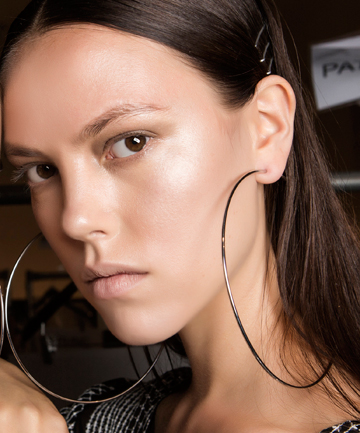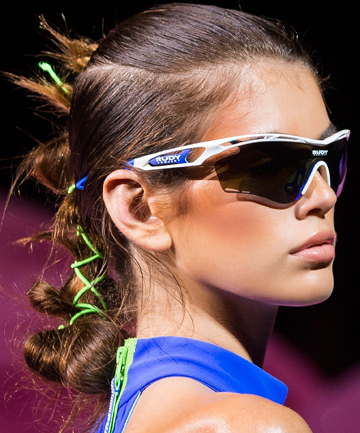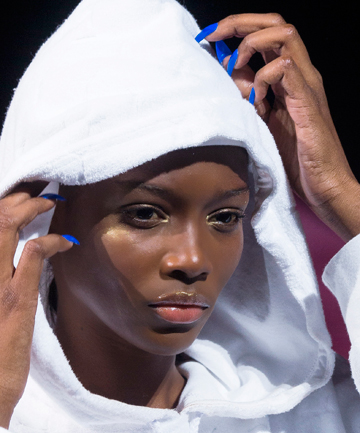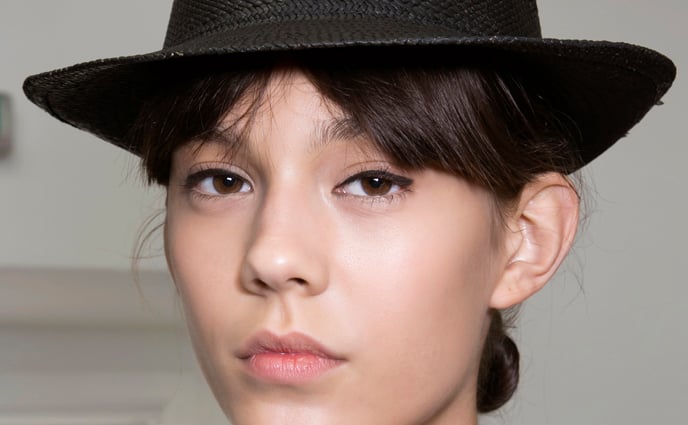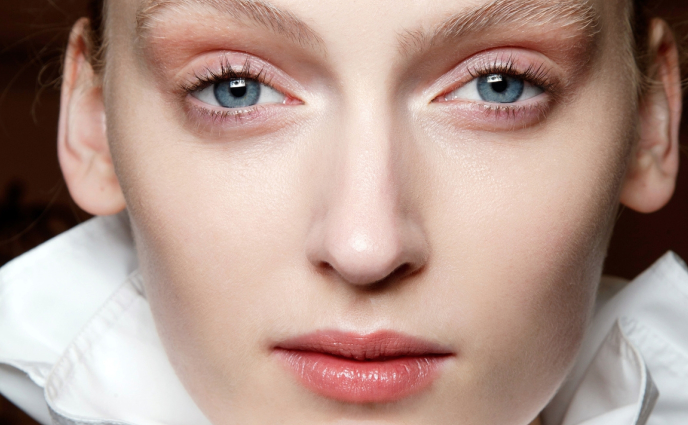The UV stands for ultraviolet, which is the light spectrum of the sun's rays that cause the most damage to human skin. The UV rays that we're most concerned with are ultraviolet A and ultraviolet B, or UVA and UVB, respectively.
UVB rays are the ones that cause sunburns and damage, while UVA radiation is responsible for wrinkles and premature skin damage. The Environmental Protection Agency ("EPA") estimates that 90 percent of skin aging is caused by a lifetime of exposure to UVA rays. Which is where SPF comes in.
Image via Imaxtree
UVB rays are the ones that cause sunburns and damage, while UVA radiation is responsible for wrinkles and premature skin damage. The Environmental Protection Agency ("EPA") estimates that 90 percent of skin aging is caused by a lifetime of exposure to UVA rays. Which is where SPF comes in.
Image via Imaxtree
SPF stands for "sun protection factor" and it's a rating of how much protection the product provides from one type of cancer-causing sunray: ultraviolet B or UVB. SPF is not a measure of protection against UVA light, nor is it (contrary to popular belief) a measure of how many minutes of protection you have (SPF 30 doesn't mean it's effective for 30 minutes). It's a multiplier of how long you can go without burning. Which means if you'd normally burn in about five minutes, an SPF of 15 means you could go 75 minutes without burning from UVB rays. The increase in the SPF number is an incremental increase in the amount of harmful UVB radiation filtered out. This means if SPF 15 filters about 93 percent of harmful UVB, SPF 30 filters about 97 percent.
Levin recommends all her patients use a broad-spectrum sunscreen with an SPF 30 or higher.
Image via Imaxtree
Levin recommends all her patients use a broad-spectrum sunscreen with an SPF 30 or higher.
Image via Imaxtree
"Sunscreen works in one of two ways: it either blocks the UV radiation from entering the skin like a shield, which is known as a physical sunscreen, or it absorbs the UV radiation via a chemical reaction converting it to heat, which is known as a chemical sunscreen," Levin says.
The difference between them lies in the ingredients. "Basically, a physical sunscreen is a physical blocker, which contains one of two metals that constitute a physical blocker: zinc oxide and titanium dioxide. They act as a shield on the skin and repel ions or inorganic particles that hit on the skin, reflecting UV radiation," Levin explains. "Meanwhile, chemical sunscreens create blockers that convert UV radiation into heat on the skin's surface. Which is why we say when you apply chemical blockers, to apply it 30 minutes before you go into the sun because it takes some time to take effect as opposed to a physical blocker, which just sits on your skin like a shield."
Regardless of which type of sunscreen you choose, a broad-spectrum product is what you'll want to ensure you're protected against both types of harmful UV radiation. Which means you'll want to make sure it has the right ingredients.
Image via Imaxtree
The difference between them lies in the ingredients. "Basically, a physical sunscreen is a physical blocker, which contains one of two metals that constitute a physical blocker: zinc oxide and titanium dioxide. They act as a shield on the skin and repel ions or inorganic particles that hit on the skin, reflecting UV radiation," Levin explains. "Meanwhile, chemical sunscreens create blockers that convert UV radiation into heat on the skin's surface. Which is why we say when you apply chemical blockers, to apply it 30 minutes before you go into the sun because it takes some time to take effect as opposed to a physical blocker, which just sits on your skin like a shield."
Regardless of which type of sunscreen you choose, a broad-spectrum product is what you'll want to ensure you're protected against both types of harmful UV radiation. Which means you'll want to make sure it has the right ingredients.
Image via Imaxtree
In addition to a good solid SPF, you'll want to seek out the right ingredients. This means looking for a broad-spectrum product that includes any of the following: cinoxate, titanium dioxide, zinc oxide, Parsol 1789 (also known as avobenzone), sulisobenzone and/or ecamsule. "The main thing is really UVA filters because the UVA chemical blockers are the ones that are hardest to stay stable," Levin says.
Ecamsule is one of the newest approved UVA blockers on the market and it's a dermatologist favorite. "It blocks a wide spectrum of UVA radiation and it wasn't readily available in the States for a long time," Levin says. But U.S. dermatologists fought for it and now it's available as an ingredient known as Mexoryl SX.
Levin is also a fan of another chemical blocker known as Helioplex, which is a stabilized version of avobenzone (aka Parsol 1789). "Helioplex is another chemical blocker that's kind of like a UVA stabilizer with different chemical filters," she says. Both Mexoryl SX and Helioplex are favorites of Levin.
When it comes to physical blockers, Levin says the best ingredients are metals, like zinc oxide and titanium dioxide, which act as a reflective shield against harmful UVA and UVB rays.
Image via Imaxtree
Ecamsule is one of the newest approved UVA blockers on the market and it's a dermatologist favorite. "It blocks a wide spectrum of UVA radiation and it wasn't readily available in the States for a long time," Levin says. But U.S. dermatologists fought for it and now it's available as an ingredient known as Mexoryl SX.
Levin is also a fan of another chemical blocker known as Helioplex, which is a stabilized version of avobenzone (aka Parsol 1789). "Helioplex is another chemical blocker that's kind of like a UVA stabilizer with different chemical filters," she says. Both Mexoryl SX and Helioplex are favorites of Levin.
When it comes to physical blockers, Levin says the best ingredients are metals, like zinc oxide and titanium dioxide, which act as a reflective shield against harmful UVA and UVB rays.
Image via Imaxtree
"People ask me all the time what's the best sunscreen and it's really the one you're going to use every day," advises Levin. Whether it's a physical sunscreen or a chemical one, she just wants you to use it. "I suggest broad-spectrum and that it be SPF 30 or higher. I tend to prefer a physical sunscreen for people with skin sensitivity and skin conditions like rosacea, but there are plenty of good chemical sunscreens out there that are well tolerated as well."
Now, let's talk about some best practices for sunscreen application.
Image via Imaxtree
Now, let's talk about some best practices for sunscreen application.
Image via Imaxtree


